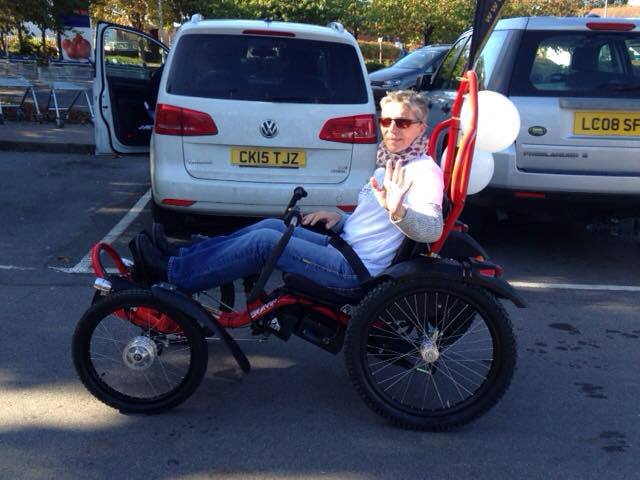
My arrival at an MS diagnosis was an unconventional one, to say the least.
Having been a long time slave to chronic back pain, when I woke up one day in 2006 numb from the waist down, I automatically assumed it was another complication. I had recently had an epidural injection which had successfully reduced the pain, but this was a whole new phenomenon and so I got straight on to my orthopaedic surgeon who agreed to see me straight away.
I hobbled in to his office like Bambi on ice, lurching from one piece of furniture to the next as no way was I going to use a wheelchair or a poxy walking stick; they’re for old gits and paraplegics! He came to the immediate conclusion that after twenty years of struggling with intermittent bouts of crippling pain, this was the thing that tipped the balance and now was the time for surgery. But, before he wielded his scalpel, he wanted me to have yet another MRI scan and come back to see him the following week to go through all the options and schedule the operation.
Over the next few days the numbness and tingling spread all down my left side from my scalp, down my face, tongue and left arm, down to my fingertips. The skin on my legs felt too tight, like sausages in a pan that needed to be pricked, but they also felt heavy, like I was wearing concrete boots. The muscles around my stomach were in spasm and it felt like I was wearing a really tight belt.
This was bizarre and the thought of spinal surgery filled me with dread. I’ve had a life long phobia of hospitals and the medical profession, avoiding them both at all costs, so the prospect of a major operation was not something I relished. However, as the surgeon himself said, I couldn’t live like this and so if an operation could cure it I would need to get a grip and stop being so pathetic.
So, when I wobbled back to his consulting room a week later I was reconciled to the fact that surgery was the solution and was ready to schedule a date. But I was totally blindsided by the following statement:
“You can’t have surgery, you’ve got MS. I can’t tell you if you’re dealing with a Chihuahua or a Great Dane, I will refer you to a neurologist. There’s nothing I can do for you.”
That was it. My MS diagnosis was as brutal as that. Just wham, bam, thank you and good night.
I was in and out of his office within three minutes. And this was private healthcare too! I was fortunate to have BUPA cover from my employer at the time, but I can only assume the surgeon hadn’t read the memo about bedside manner and how to break bad news with a degree of compassion!
I went out to reception, told my mum the bombshell and we drove home in silence. The only thing I remember her saying to me was that I would have to start smoking cannabis, as that’s what people with MS do. When we got back to my parent’s house I broke the news to my dad with a wisecrack about being eligible for a Blue Badge……every cloud and all that crap!
I knew nothing about MS. It had never been mentioned as even a remote possibility and so I was in total shock. This was a body blow. I spent the next couple of weeks feverishly researching everything I could about it whilst I was waiting for my referral to the neurologist.
And the more I Googled, the more things fell in to place.
Several years earlier, following a car accident where I had sustained whiplash, I had lost the sight in one eye and my left arm had gone numb for a period of time. Both had completely resolved after a few months, but had been put down to the bang to my head.
The year before, I had been on holiday to Thailand with my buddy The Pipster. We were walking in to a restaurant one evening and suddenly, without any warning, my legs collapsed beneath me and I went down like a sack of spuds and couldn’t get up. This was largely because I was was in a fit of hysterical laughter, but also due to my legs being transformed to useless lumps of jelly. The laughter was exacerbated when the poor Thai lady welcoming us to the eatery was mortified at my calamity and desperate to assist me to my feet, but she was told by The Pipster to “ignore her, she does this all the time”.
Don’t judge her too harshly. We’ve known each other for over forty years; banter and mutual mickey taking is the way we roll.
Just months earlier The Pipster and I had been to New York; she was on a business trip and kindly used her air miles to pay for a ticket for me to accompany her and turn it into a holiday. Rather inconveniently, she did actually have to do some work while we were there, so on the day she had to go in to the office I chose to hit the sales.
I spent the day trawling through the multitude of bargains on offer in Macy’s and, quite literally, shopped until I dropped. I couldn’t understand why my legs kept filling up with lead and I had to keep having coffee breaks every hour to revive my very weary limbs.
At the end of the day, laden with bags full of “must haves”, I was stumbling around outside the mall, wondering how the hell I was going to make it back to the hotel and why my legs were doing this, when a kind security guard took pity on me. He found a chair and insisted I take a seat while he called a cab to take me home. With hindsight, I suspect he probably thought I was drunk. But I was very grateful for his help and after I had sat for a few minutes my legs had recovered sufficient strength to get me back to the hotel and show The Pipster my many purchases.
As I had suffered several bouts of sciatica over the years, which were all caused by my deteriorating spine and bulging discs, I had just assumed that all of these episodes of weak and wobbly legs were attributable to the same thing; so had the orthopaedic surgeon. But as soon as I began reading up about MS and the many and various gifts it brings with it, it all made perfect sense. I can’t actually believe now that it took so long for him to consider it as an option.
By the time the neurologist’s appointment came around I’d had time to get used to the idea and was anxious to hear what form of MS I had and if I would be eligible for treatment. My research had revealed that there were several different types of MS; if I had either Primary or Secondary Progressive MS then the treatment options were very limited.
At this stage my symptoms had improved, the numbness and tingling was easing and my legs were gradually increasing in strength. But it was with a degree of trepidation that I hobbled in to that appointment, and this time I dragged my mum in with me for moral support and to ensure she heard everything straight from the horse’s mouth, rather than me having to relay it all after the event.
He gave me a full examination, took my medical history, talked me through my scans by pointing out the numerous lesions on my brain and spinal cord, and told me my diagnosis was unequivocal; I had Relapsing Remitting MS. This meant I was eligible for disease modifying drugs which I would need to self inject, and he would refer me to one of his colleagues who would prescribe them for me under the NHS. I’m glad to say he was very charming and answered all of our questions very patiently, the total antithesis to his surgeon colleague which made a pleasant change.
And so that is how my rocky journey with MS commenced. Within a couple of months, a nurse had visited my home and I was injecting myself with Beta Interferon three times a week, which slowed the relapses down and I was well enough to go back to work.
Going back to the surgeon’s delightful and sensitive analogy, I wouldn’t say that my particular flavour of MS falls within either the Chihuahua or Great Dane breed. Everyone with MS experiences something different and unique; no two people’s symptoms are exactly the same.
I regard my MS, not as a thoroughbred, but as a pesky, ill-trained mongrel. After almost eleven years of living together, I’ve learned how to co-habit with it and roll with the punches. But, every now and then, it bites me on the bum or nips my heels to remind me who really is the boss of this relationship.

If you have any comments or similar experiences I would love to hear from you.






